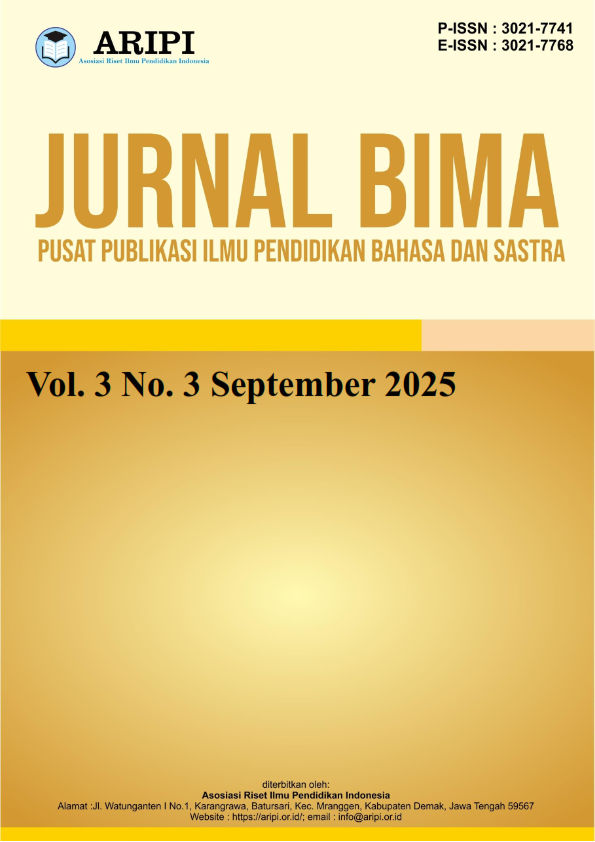A Sociolinguistic Study of English Abbreviations Frequently Used by Gen Z on Tiktok
DOI:
https://doi.org/10.61132/bima.v3i3.2158Keywords:
Abbreviations, Digital-Language, Gen-Z, Sociolinguistic, TikTokAbstract
This study explores the sociolinguistic functions of English abbreviations frequently used by Generation Z on TikTok. Using a qualitative descriptive approach, the research identifies 30 commonly used abbreviations and categorizes them according to their linguistic functions. The analysis reveals that these abbreviations serve expressive, interpersonal, informative, and contextual purposes. Their frequent use on TikTok reflects Gen Z’s unique digital identity and language practices shaped by social media culture. The study highlights the sociolinguistic significance of abbreviations as tools for identity performance, emotion expression, and community engagement in online communication.
This study explores the sociolinguistic functions of English abbreviations frequently used by Generation Z on TikTok. Using a qualitative descriptive approach, the research identifies 30 commonly used abbreviations and categorizes them according to their linguistic functions. The analysis reveals that these abbreviations serve expressive, interpersonal, informative, and contextual purposes. Their frequent use on TikTok reflects Gen Z’s unique digital identity and language practices shaped by social media culture. The study highlights the sociolinguistic significance of abbreviations as tools for identity performance, emotion expression, and community engagement in online communication.
Downloads
References
Anggraini, R., & Hidayat, M. (2024). TikTok as a Sociolinguistic Space: Identity and Language Use among Indonesian Gen Z. Journal of Digital Language Studies, 6(1), 22–34.
Ananda, F., & Lestari, R. (2022). Abbreviations in Social Media: A Case Study of Gen Z Instagram Users. Journal of English Language Studies, 10(1), 88–97.
Crockett, A. (2022). Digital Belonging and Abbreviated Talk on TikTok. Social Media & Language Journal, 4(3), 45–61.
Crystal, D. (2008). Txtng: The Gr8 Db8. Oxford: Oxford University Press.
Danet, B., & Herring, S. C. (2007). The Multilingual Internet: Language, Culture, and Communication Online. Oxford University Press.
Eble, C. (2012). Slang and Sociability: In-group Language among College Students. Chapel Hill, North Carolina: University of North Carolina Press.
Kusyairi, Hikmah, & Qomariyah, N. (2024). Use of Language Variations on TikTok Social Media in Generation Z. Interdisiplin: Journal of Qualitative and Quantitative Research, 1(3), 140–153. https://doi.org/10.61166/interdisiplin.v1i3.33
Nguyen, T. L. (2021). Platform Culture and Linguistic Economy in TikTok Discourse. Asian Journal of Media Linguistics, 5(2), 91–103.
Pramesti, F., & Agustin, D. (2023). An Analysis of Slang Words on TikTok by Gen Z. Jurnal Bahasa dan Sastra, 11(1), 44–51.
Rizki, R. A. (2023). Linguistic Features of Youth Slang on TikTok Comments Section. Jurnal Ilmiah Bahasa dan Sastra, 7(2), 55–63.
Sulistiyarini, S., & Prasetyo, G. T. (2024). Language Variations of Adolescents on TikTok Social Media. Metathesis: Journal of English Language, Literature, and Teaching, 8(1), 33–42. https://doi.org/10.31002/metathesis.v8i1
Tagg, C. (2015). Exploring Digital Communication: Language in Action. London: Routledge.
Downloads
Published
How to Cite
Issue
Section
License
Copyright (c) 2025 Jurnal Bima : Pusat Publikasi Ilmu Pendidikan Bahasa dan Sastra

This work is licensed under a Creative Commons Attribution-ShareAlike 4.0 International License.






